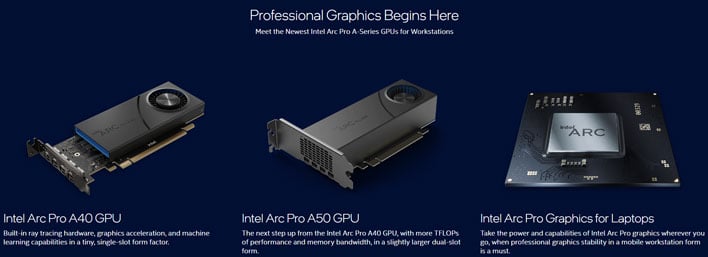Intel Reveals Arc Pro A40 And A50 Desktop Professional Graphics With A30M Mobile
In the press release, Intel noted hardware support for ray-tracing workloads and machine learning capabilities and “industry-first” AV1 hardware encoding support. The company has been grilled in recent weeks over continued delays in bringing Arc products to market. Yet, even as reports speculate about driver or even hardware level defects plaguing the launch, the consumer-oriented Arc A380 has been capturing attention for its promising AV1 encoding capability.
The Intel Arc Pro A50 is the higher tier desktop GPU offering. The A50 spans two PCI-e slots and offers 6GB of GDDR6 with 8 ray-tracing cores. Intel rates its performance at 4.8 TFLOPs of single precision number crunching, which sizes it below NVIDIA’s RTX A2000. The Arc Pro A50 is rated for slightly more power draw at 75W to the RTX A2000’s 70W. While the pricing has not been announced, Intel will need to be very aggressive to make the Arc Pro A50 an attractive alternative. These specifications are right in line with the Arc A380 for those keeping track.
The smaller Arc Pro A40 retains most of its larger sibling’s performance in a single-slot design. The Arc Pro A40 is rated for 3.5 TFLOPs with a 50W peak power designation. Nevertheless, the Arc Pro A40 retains 6GB of GDDR6 and 8 ray tracing cores. This stacks up more favorably against NVIDIA’s T1000 GPU which shares a 50-watt rating, but only pulls 2.5 TFLOPs with no hardware ray-tracing support.
The mobile-oriented Arc Pro A30M shares virtually all the same specifications of its desktop counterparts. All three cards leverage 128 execution units with a base clock of 2000 MHz. The only difference on paper is the memory configuration. Where the desktop GPUs both supply 6GB of GDDR6, the Arc Pro A30M is limited to just 4GB of GDDR6 and uses a smaller 64-bit interface for only 128 GB/s of effective memory bandwidth. The desktop GPUs both utilize a 96-bit interface providing 192 GB/s of memory bandwidth.
This announcement does not constitute a formal launch for Intel. The company indicates that these Intel Arc Pro GPUs will be available later this year. In the meantime, the company is demonstrating systems with these graphics cards onboard at their SIGGRAPH booth, #427. While these cards are destined for small-formfactor and mobile computers, the company’s true high end graphics card offerings continue to lurk in the shadows.


